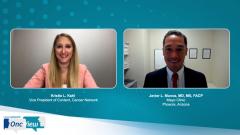
Changes in Sequencing of R/R FL Therapies
Javier L. Munoz, MD, MS, FACP, discusses how the sequencing of therapies has changed in the last year.
Kristie L. Kahl: Can you talk about the efficacy in patients with the EZH2 mutation and in the wild-type population?
Javier L. Munoz, MD, MS, FACP: This clinical trial, again, published in Lancet Oncology in October 2020, slightly behind the actual FDA approval of tazemetostat for follicular lymphoma in June 2020, regarding efficacy and looking at the primary end point of PFS [progression- free survival], it was 13.8 months in the EZH2 mutated cohort and 11.1 months in the EZH2 wild-type cohort. Regarding toxicity, grade 3 or higher events were uncommon. When it comes to thrombocytopenia, it was 3%; neutropenia, grade 3 or higher, 3%; and 2% when it comes to anemia. There were no treatment-related deaths. So as a summary, what are the implications of this approval in the treatment of follicular lymphoma? You have a new oral option. It's a nonchemotherapy agent that has, luckily, small levels of severe grade 3 or higher toxicity, and has a reasonable efficacy when it comes to the primary end point of the study, progression-free survival in this case.
Kristie L. Kahl: Dr Munoz, how has sequencing of therapy changed over the last year? In particular, where does [tazemetostat] fit into your treatment plan? Moreover, how does the availability of new therapies affect your sequencing?
Javier L. Munoz, MD, MS, FACP: Relapsed follicular lymphoma typically responds to additional therapy. The duration of remission usually becomes shorter with each subsequent therapy. As we have acquired more tools in the tool belt, the sequencing of therapies also becomes more challenging. Most patients with follicular lymphoma experience multiple relapses and will be treated with many of the available agents at some point during their journey. It is not necessarily a question of if, but rather a question of when. A preferred therapeutic paradigm has not been established, and it depends on patient characteristics and disease characteristics. There are some treatments that are intravenous, and some are oral, as you know. My personal bias is to avoid chemotherapy regimens as much as possible. Even more so during this COVID-19 pandemic, I have tried very hard to favor oral novel agents instead of prescribing intravenous chemotherapies, to try to keep the patients at home as much as possible. So, I'm very happy to have oral therapies available, particularly as my treatment focuses on symptom control and improvement of quality of life instead of other end points.
Regarding tazemetostat, I use it per label, so that would be for patients with an EZH2 mutation, with relapsed/refractory disease after 2 or more lines of systemic therapy, or for EZH2 wild type or unknown with relapsed/refractory disease in patients who do not have satisfactory alternative options. While testing for EZH2 mutations can identify patients who are more likely to respond to the EZH2 inhibitor, responses have also been seen in patients without EZH2 mutations. For patients who can tolerate the expected toxicity from CAR [chimeric antigen receptor] T cells and who have faced short duration of remission, for example, POD24 [progression of disease within 24 months], I do consider CAR T cells a viable option. For most of the patients, I choose one of the novel agents that are FDA approved in the third line or later, and of course I always consider enrolling a patient in a clinical trial, if such an option is available.
Kristie L. Kahl: Thank you, and thank you all for watching Cancer Network®'s OncView® program from MJH Studios™. We hope you found this to be valuable to your clinical practice.
Transcript edited for clarity.
Newsletter
Stay up to date on recent advances in the multidisciplinary approach to cancer.

















































































